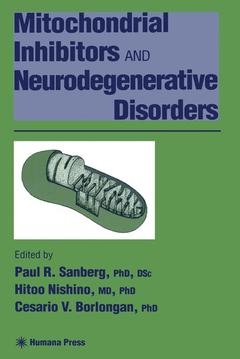Description
Mitochondrial Inhibitors and Neurodegenerative Disorders, Softcover reprint of the original 1st ed. 2000
Contemporary Neuroscience Series
Coordinators: Sanberg Paul R., Nishino Hitoo, Borlongan Cesario V.
Language: English
Subject for Mitochondrial Inhibitors and Neurodegenerative Disorders:
Publication date: 07-2012
314 p. · Paperback
314 p. · Paperback
Description
/li>Contents
/li>
Mitochondria have long been the Rodney Dangerfield of cellular organelles. Believed to be the remnants of bacterial infection of eukaryotic cells eons ago, the mitochondrion evolved a symbiotic relationship in which it dutifully served as the efficient source of A TP for cell function. The extraordinary dependence of cells on the energy provided by mito chondrial oxidative metabolism of glucose, especially through critical organs such as the heart and brain, is underlined by the fatal consequences of toxins that interfere with the mitochondrial electron transport system. Consistent with their ancestry, the mitochondria have their own DNA that encodes many but not all of their proteins. The mitochon dria and their genes come from the mother via the ovum since sperm do not possess mitochondria. This extranuclear form of inheritance derived exclusively from the female side has proven to be a powerful tool for tracing the evolution by the number of base substitutions in mtDNA. That mitochondrial gene mutations might be a source of human dis ease became evident a decade ago with the characterization of a group of multisystem disorders, typically involving the nervous system, which are transmitted from mother to child. Specific point mutations in mtDNA have been associated with the different syndromes.
I. Mitochondrial Toxins: Symptomatology, Origin, and Chemistry.- 1 • Clinical Manifestations and Mechanisms of Action of Environmental Mitochondrial Toxins.- 2 • History of 3-Nitropropionic Acid: Occurrence and Role in Human and Animal Disease.- 3 • The Neurochemistry of 3-Nitropropionic Acid.- II. Mitochondrial Dysfunctions: Models of Neurodegeneration and Mechanisms of Action.- 4 • In Vitro Studies of 3-Nitropropionic Acid.- 5 • Cognitive and Motor Deficits Produced by Acute and Chronic Administration of 3-Nitropropionic Acid in Rats.- 6 • Comparative Study on 3-Nitropropionic Acid Neurotoxicity.- 7 • Mechanisms of 3-Nitropropionic Acid Neurotoxicity.- 8 • Gender-Related Difference of the Effect of 3-Nitropropionic Acid on Striatal Artery.- 9 • Variable Susceptibility to Neurotoxicity of Systemic 3-Nitropropionic Acid.- 10 • The 3-Nitropropionic Acid Model of Huntington’s Disease: Do Alterations in the Expression of Metabolic mRNAs Predict the Development of Striatal Pathology?.- 11 • Mechanisms of Action of 3-Nitropropionic Acid: Dopamine Overflow and Vulnerability of the Lateral Striatal Artery.- 12 • Mitochondrial Inhibition and Neuronal Death in Huntington’s Disease.- 13 • Effects of Brain Mitochondrial Metabolism, Aging, and Caloric Restriction on Membrance Lipids and Proteins: An Electron Paramagnetic Resonance Investigation.- 14 • Malonate: Profile and Mechanisms of Striatal Toxicity.- 15 • Malonic Acid and the Chronic Administration Model of Excitotoxicity.- 16 • Sodium Azide-Induced Neurotoxicity.- III. Treatment Interventions for Mitochondrial-Induced Neurotoxicity.- 17 • Neuroprotective Strategies Against Cellular Hypoxia.- 18 • Neuroprotective Effect of Perinatal Hypoxia Against 3-Nitropropionic Acid Neurotoxicity.-19 • Neural Transplantation and Huntington’s Disease: What Can We Learn from the 3-Nitropropionic Acid Model?.- 20 • Neuroprotective Strategies in Parkinson’s Disease and Huntington’s Chorea: MPTP- and 3-NPA-Induced Neurodegeneration as Models.
© 2024 LAVOISIER S.A.S.

